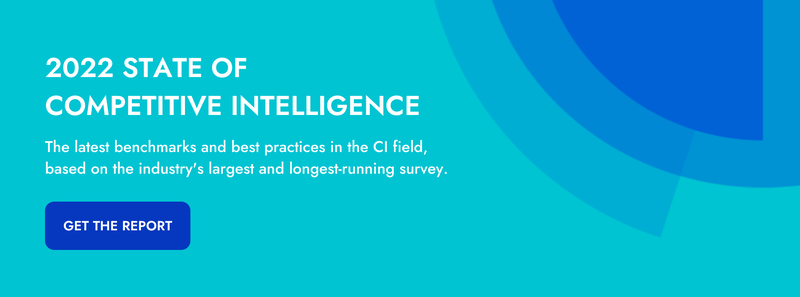Most marketers and competitive intelligence (CI) pros would agree that gathering competitive insights is only a valuable activity if those insights are used to further key business goals. Almost every organization with a CI program leverages competitive intelligence in making strategic business decisions. Tactical applications of CI, like battlecards and competitor matrices, are also perennial favorites that can be leveraged by nearly any organization.
However, the most valuable applications of competitive intelligence are rarely so straightforward. One common trait possessed by marketers and CI pros with a higher level of CI maturity is their creative application of competitive intel. These three uses for CI may not be as widely applicable as competitor matrices or battlecards, but they provide an outsized opportunity to positively impact your business.
Track Large Customers
If your customers are large enough and provide considerable recurring revenue, keeping an eye on their movements can prove valuable. The extent of your tracking does not need to match that of your direct competitors. However, there are several key signals to watch for that can help hedge against losing their business or indicate opportunities to expand your relationship.
- Major Hiring Trends: Sudden increases in job postings can mean growth into new regions, expansion of product lines, or any number of other strategic moves depending on the nature of the hiring. Key executive leadership changes can also spell a variety of positive or negative changes.
- Geographic/Channel Expansions: Office openings in new locations means opportunities for relationship expansion. Similarly, expansions into new channels of sale, product lines, or any other similar extension of their go-to-market machine can provide similar upsell opportunities.
- New Funding: This can take many forms. If your customers are privately owned, new venture capital or other investor funding means more budget to work with. Public companies and governmental entities are even easier to track as infusions of new cash are publicly announced.
These are three specific examples with applicability that will vary depending on the nature of your customers. Generally speaking, any intel your customer-facing team can use to spark upsell conversations and mitigate churn should be the highest priority. Be sure to meet with members of that team to find out what types of intel they find most valuable and the medium by which they want to receive that intel.
 Run Competitive Sales/Marketing Campaigns
Run Competitive Sales/Marketing Campaigns
Tracking competitors and using the intel gleaned against them is the foundation of nearly every CI program. However, less commonly leveraged is the ability to weaponize certain tactical insights in targeted sales/marketing campaigns. When your competitors slip up, a timely response can fuel effective campaigns.
The exact weaknesses to watch for will depend on the nature of your business. Here are a few of the most common use cases:
- Negative Reviews: Business review sites like G2, Capterra, and Trustpilot are gold mines of competitive ammo. Volume is key here - one or two bad reviews constitutes anecdote. A steady stream of reviews bashing a key feature of your competitor is data-driven ammunition.
- Social Media/Forums: The concept here is similar to review sites. Monitor forums, social media, Quora - any website where customers/users talk about your competitors. When plentiful, negative commentary is valuable.
- Downtime: When software or websites crash, users/customers get angry. Capitalize on that. If your product has better reliability metrics than your competition, there’s no better time to run competitive sales/marketing blitzes than a competitor’s service outage.
- Bad Press: Maybe an employee is embezzling company money. Perhaps an executive said something uncouth in an interview. Certain scandals warrant competitive comebacks, and working with your marketing/PR team on timely responses can lead to a highly effective marketing campaign.
These are just a few examples of slip-ups to watch for. The important part of this strategy is the execution. Whether your response to a competitor’s gaffe takes the form of an ad blitz or a targeted burst of sales outreach, ensure your message is one that reflects well on your business. For example, if a competitor’s software has experienced downtime, work with sales and marketing on a timely campaign that highlights your own product’s reliability without directly attacking the competition.
Feed Your Talent Pipeline
The labor market is currently the tightest it’s been in recent history. Hiring for most roles is difficult, but for certain roles in engineering and sales, the talent war is particularly intense. For CI pros on the cutting edge, this is a unique opportunity to positively impact an entirely new area of their business.
- Major Layoffs: If a competitor (or even a company that competes with you on talent acquisition) experiences noticeable layoffs, make sure to alert your talent team as soon as possible. Those best of those newly-available free agents will only remain available for a short period of time, so speed is everything.
- Unhappy Employees: Employee review websites like Glassdoor and Indeed are excellent sources of all kinds of intel. One overlooked application of employee reviews is understanding when a company has disgruntled employees. A wave of deeply negative reviews indicates a company’s employees would be much more receptive to an offer from your talent team.
Hiring is a major cost-driver, especially for growing companies. Applying a competitive mindset to that process is a creative way to drive ROI of your CI program.
These are just three examples of creative applications of competitive intelligence. Differing products, go-to-market strategies, and organizational structures means that some of these use cases will be more valuable than others, depending on your organization. CI pros should strive to view themselves as “internal consultants” if they want to level up the impact of their work. Understanding the unique goals and strategies of each team in your organization will make conjuring up even more creative applications of the intel you’re already gathering easier.

Related Blog Posts
Popular Posts
-
 The 8 Free Market Research Tools and Resources You Need to Know
The 8 Free Market Research Tools and Resources You Need to Know
-
 How to Measure Product Launch Success: 12 KPIs You Should Be Tracking
How to Measure Product Launch Success: 12 KPIs You Should Be Tracking
-
 24 Questions to Consider for Your Next SWOT Analysis
24 Questions to Consider for Your Next SWOT Analysis
-
 How to Create a Competitive Matrix (Step-by-Step Guide With Examples + Free Templates)
How to Create a Competitive Matrix (Step-by-Step Guide With Examples + Free Templates)
-
 6 Competitive Advantage Examples From the Real World
6 Competitive Advantage Examples From the Real World




